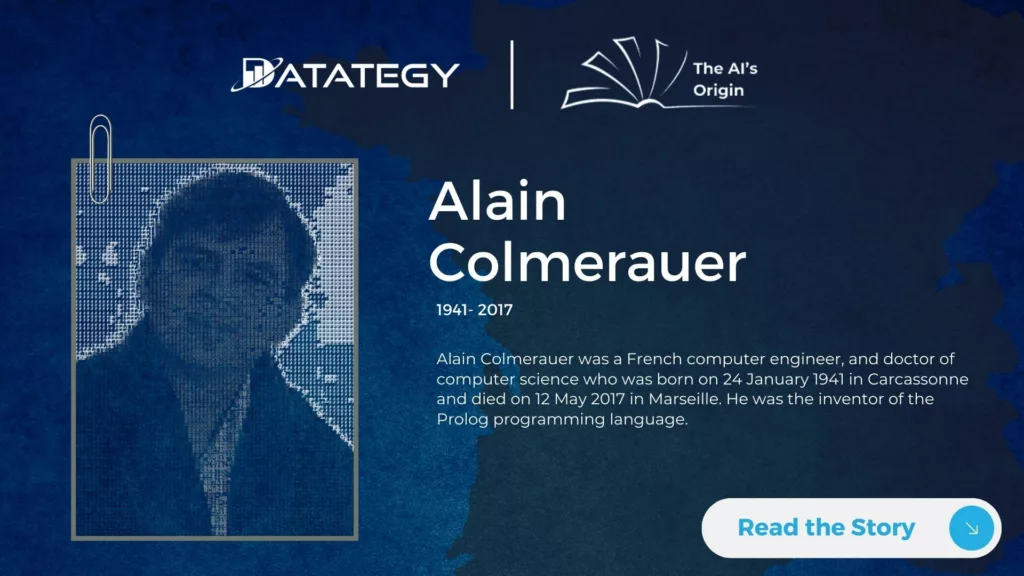Transform Defense Logs & Rapport into Situational Awareness with AI...
Read MoreWelcome to ” The AI’s Origin “ series. In this collection of articles, we take you on an inspiring journey through the history of artificial intelligence, focusing on the remarkable individuals who have played a crucial role in making AI accessible to everyone.
Throughout these articles, we’ll dive into the life stories and contributions of these innovative minds who have reshaped the AI landscape, paving the way for a more inclusive and transformative future. Join us as we celebrate the human ingenuity behind the AI revolution and explore the extraordinary individuals who have made it all possible.

Alain Colmerauer was a renowned French computer scientist and researcher in the field of artificial intelligence and logic programming. He graduated from Ensimag (L’École nationale supérieure d’informatique et de mathématiques appliquées) in Grenoble, where he defended his thesis on the syntactic analysis of programming languages. He then worked on the automatic translation of weather forecasts from English into French at the University of Montreal in Canada, where he invented Q-systems, a method of transforming graphs according to given grammar rules.
Key Dates About Alain Colmerauer
| Date | Event |
|---|---|
| 1941 | Alain Colmerauer is born in Carcassonne, France. |
| 1963 | Colmerauer graduates with a degree in Mathematics from the University of Paris. |
| 1970 | He develops the Prolog programming language, a significant contribution to artificial intelligence. |
| 1982 | The pomme d'Or award for French Software. |
| 2007 | He receives the ACM SIGPLAN Programming Languages Achievement Award for his work on Prolog. |
| 2017 | Alain Colmerauer passes away, leaving a lasting legacy in the field of artificial intelligence. |
A Major Contribution to the Development of Logic Systems
In 1970 Alain Colmerauer and his team developed Prolog (logic programming), a programming language based on first-order logic that revolutionized the field of AI. Nicknamed the father of logic programming, Alain Colmerauer influenced the researchers of his day and continues to be a source of inspiration throughout the world.
He gained international recognition with the creation of the Prolog language, marking a significant step in the evolution of artificial intelligence by integrating constraints into programming. A documentary entitled “Alain Colmerauer, the Prolog Adventure” has been specially produced to pay tribute to him. It retraces his life and career. His influence was deeply felt by the researchers of his time and continues to inspire them to this day.
Prolog is a programming language based on first-order logic that revolutionized the field of AI. this program quickly became an essential tool for natural language processing, and automatic planning, In 1980, he worked on a Japanese fifth-generation computer project as a consultant. In 1982, he won the ” pomme d’Or du Logiciel français” for implementing prolog II on the Apple II, a prize he shared with other researchers. In 1984, he founded the company Prologia to market the Prolog language and develop solutions to complex problems. According to him, “Prologia is a story of passionate men and women”.
Benefits of Prolog in NLP
| Benefit | Details |
|---|---|
| Expressive Knowledge Representation | Prolog's declarative and rule-based nature allows for natural and expressive representation of linguistic rules and knowledge, making it well-suited for NLP tasks. |
| Pattern Matching | Prolog excels in pattern matching, which is essential in processing and analyzing linguistic patterns, such as syntax and semantics, in text and speech. |
| Rule-Based Inference | Prolog's rule-based reasoning is beneficial for NLP applications, enabling the creation of rule engines for tasks like sentiment analysis, text classification, and chatbots. |
| Natural Language Understanding | Prolog can be used to build systems that understand natural language queries, enabling human-like interactions with machines through chatbots and virtual assistants. |
| Support for Semantic Web | Prolog's compatibility with semantic web technologies facilitates the integration of structured and unstructured data for advanced NLP tasks, such as information extraction and knowledge graph construction. |
New AI users continue to experience innovative impacts even today

Prolog was an essential part of the symbolic learning approach, and was used to understand the logic behind the decisions made by a model, thus facilitating the validation process.
Radhia HARMASSI
- Data Scientist at Datategy
Interested in discovering papAI?
Our AI expert team is at your disposal for any questions
Why AIOps Is Key to Cyber Threat Detection in Defense?
Why AIOps Is Key to Cyber Threat Detection in Defense?...
Read MoreHow AI Transforms Predictive Maintenance in Defense Equipment
How AI Transforms Predictive Maintenance in Defense Equipment In a...
Read MoreHow to Scale AI Without Breaking Your Infrastructure in 2025
How to Scale AI Without Breaking Your Infrastructure in 2025...
Read More


